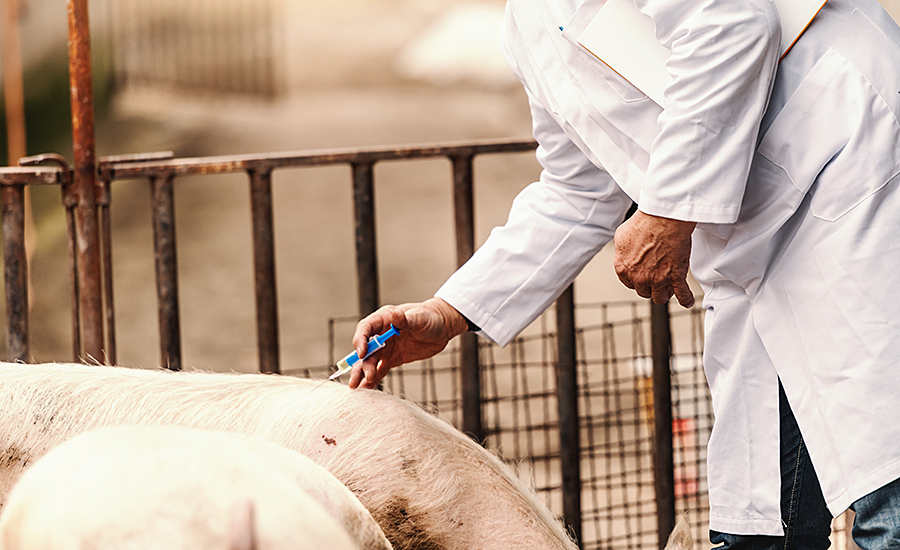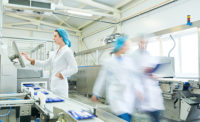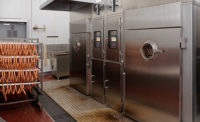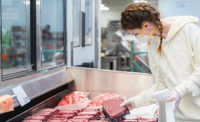The three main components of pre-harvest intervention — probiotics and prebiotics in animal feed, pathogen resistance through vaccines or antimicrobials, and biosecurity protocols — all work together to reduce foodborne pathogens in beef, poultry and pork. Each operation, however, has to tinker with the formula to create its ideal solution.
The basic building blocks of a well-run production are clean feed, clean water, an appropriately drained and maintained environment and biosecurity, according to the National Cattlemen’s Beef Association, based in Centennial, Colo.
From there, researchers continue to study how animal feed — the type of feed, frequency of feeding and feed quality — can be used to prevent pathogen contamination, as it has been hypothesized to influence bacterial shedding rates in cattle, for example.
“Most strategies have been implemented for some time, but there is better knowledge on how to use them,” says Rafael Rivera, manager, food safety & production programs, U.S. Poultry & Egg Association, based in Tucker, Ga. “Nutritionists and veterinarians check gut microbiome, for example, to determine which prebiotics or vaccines to use and when it is best to use them.”
Any strategy will depend on what microbiomes are in farmers’ barn and birds. “It is location specific,” says Rivera. “What works is collecting information that helps you make the best decisions.”
To prevent antibiotic resistance in animals (and consumers), companies and researchers are trying different combinations of microorganisms to see their benefits versus risks.
“A few [direct-fed microbials] are out on the market now,” notes Mahesh N. Nair, Ph.D., assistant professor, Center for Meat Safety and Quality, department of animal sciences, Colorado State University, based in Fort Collins, Colo. “We’re working on a couple different combinations of direct-fed microbials as a feed additive.”
Direct-fed microbials are similar to probiotics, which are bacteria or microorganisms beneficial to the host animal that can also reduce bad pathogens. Research has shown that the Lactobacillius-based direct-fed microbial, for one, reduced E. coli O157:H7 in cattle and decreased hide contamination. In fact, five Lactobacillius strains have shown potential to increase pathogen shedding, not just decrease it.
Another potential area of interest is looking at how cattle’s immune system interacts with Salmonella. “Research showed that Salmonella can get in cattle’s lymph nodes and then potentially the product,” says Nair. “It’s almost impossible to screen for because there are so many lymph nodes in their body [more than 200], including deep ones that can’t be removed. We don’t have a clear answer for preventing this area of transmission yet, but it is of interest to us to research how Salmonella interacts with the cattle’s immune cells.”

Another step in the multiple hurdle approach to food safety is carcass washes. Cattle are washed prior to harvest to remove visible manure, which may reduce the chance of contamination when the hide is removed.
“There are always antimicrobials in the hide washes, but they can be used more consistently,” says Nair.
Environmentally friendly strategies to clean and recycle water used in carcass washes continue to improve.
“Processing plants look into reducing water consumption and install equipment that helps them achieve this goal,” says Rivera. “One thing to keep in mind is the ability for this new equipment to deliver antimicrobial treatment efficiently and in the concentrations necessary to control foodborne pathogens while being conservation conscious.”
Biosecurity procedures in general are effective if implemented correctly with the knowledge of what pathogens are present and require attention. “Proper testing to know which pathogens are present can help you implement the best strategy that is specific for your operation,” says Rivera.
Certainly, animals developing antibiotic resistance is a growing problem. Implementing targeted pest control programs specific to the needs of each producer can help producers avoid building antibiotic resistance in their animals, while using biosecurity methods that won’t cause harm beyond what they’re trying to control.
“With the advent of antibiotic-free production, more emphasis has been placed on overall farm hygiene, cleaning and disinfection procedures for equipment, and minimizing exposure of foot, vehicle and equipment traffic to keep pathogens out of barns,” says Rivera. NP





Report Abusive Comment